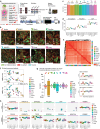The proteomic landscape of in vitro cultured endothelial cells across vascular beds
- PMID: 39143368
- PMCID: PMC11324761
- DOI: 10.1038/s42003-024-06649-w
The proteomic landscape of in vitro cultured endothelial cells across vascular beds
Abstract
Blood vessel endothelial cells (EC) display heterogeneity across vascular beds, which is anticipated to drive site-specific vascular pathology. This heterogeneity is assessed using transcriptomics in vivo, and functional assays in vitro, but how proteomes compare across human in vitro cultured ECs remains incompletely characterized. We generated an in-depth human EC proteomic landscape (>8000 proteins) across six organs and two in vitro models in steady-state and upon IFNγ-induced inflammation. EC proteomes displayed a high similarity and organ-specific proteins were limited. Variation between ECs was mainly based on proliferation and differentiation processes in which Blood outgrowth endothelial cells (BOEC) and Human umbilical vein cells (HUVEC) represented the extremes of proteomic phenotypes. The IFNγ response was highly conserved across all samples. Harnessing dynamics in protein abundances we delineated VWF and VE-Cadherin correlation networks. This EC landscape provides an extensive proteomic addition in studying EC biology and heterogeneity from an in vitro perspective.
© 2024. The Author(s).
Conflict of interest statement
The authors declare no competing interests.
Figures





References
Publication types
MeSH terms
Substances
Grants and funding
LinkOut - more resources
Full Text Sources
Miscellaneous

